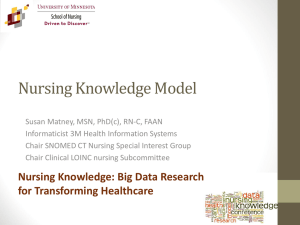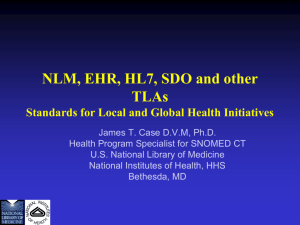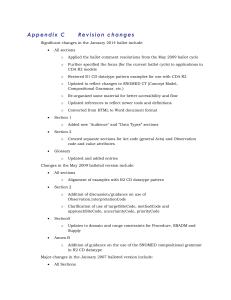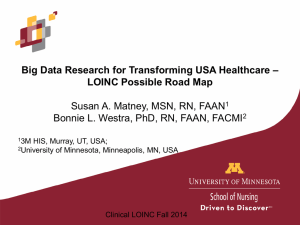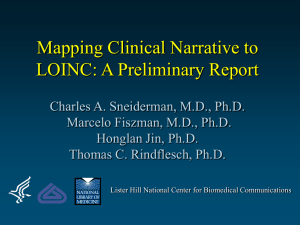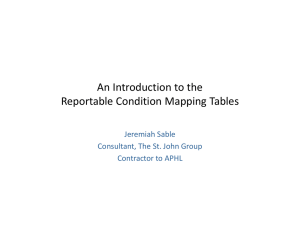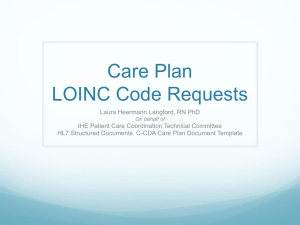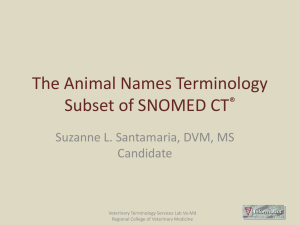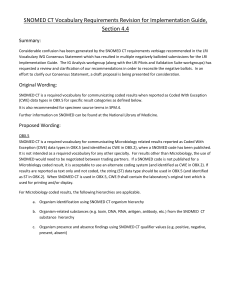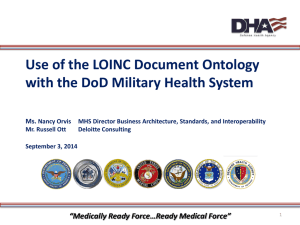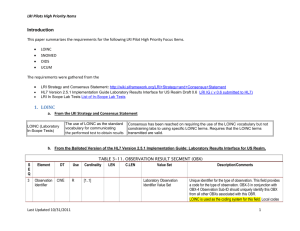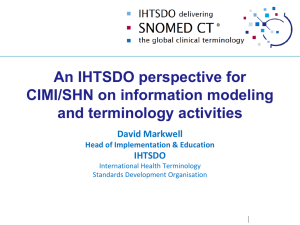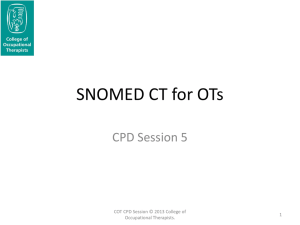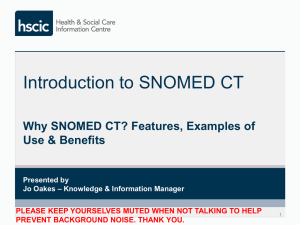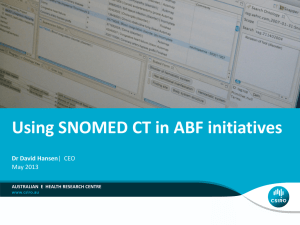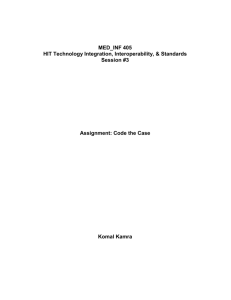LOINC and SNOMED - HL7 E Learning Course
advertisement
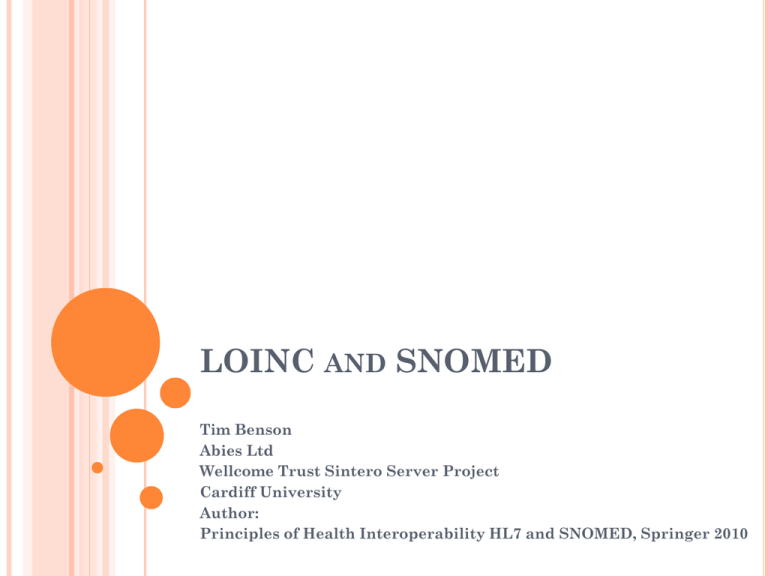
LOINC AND SNOMED Tim Benson Abies Ltd Wellcome Trust Sintero Server Project Cardiff University Author: Principles of Health Interoperability HL7 and SNOMED, Springer 2010 OUTLINE Origins of LOINC Origins of SNOMED CT Complementary or Competitive SCOPE OF LOINC Clinical Laboratory Tests The test not the result Clinical observables “Eye colour”, not “Blue eyes” Form headings Document types Assessment scales ORIGINS OF LOINC Logical Observation Identifiers Names and Codes Designed for use in interoperability Clem McDonald ASTM 1238:88 Standard Specification for Transferring Clinical Laboratory Data Between Independent Computer Systems HL7 V2.0 1988 OBX Segment EU EUCLIDES and OpenLabs projects HL7 V2 OBX SEGMENT Turn-round document Observable Code Value Code Physical quantity EUCLIDES European Clinical Laboratory Data Exchange Standard 1988-1991 Georges De Moor, Gent 6 dimensional classification LOINC CODES LOINC Code Consecutive number + Check digit e.g. 12345-9 Short convenient name Long common name All codes are pre-coordinated to common concept model Six dimensions slightly different from EUCLIDES LOINC DIMENSIONS Component Property sample or body part Scale point in time or period System kind of property measured Timing what is being measured nominal, ordinal, interval or ratio Method procedure used to produce the result or other observation RELMA Regenstrief LOINC Mapping Assistant LOINC database search Map local codes to LOINC codes PROBLEMS OF LOINC Complex Many similar codes with only small differences mass concentration v molecular concentration anatomical position of pulse or BP Dimensions are not hierarchical so limits subsumption testing GOOD ASPECTS OF LOINC Completely free Does what it claims to do (but no more) Fit for purpose Easy and quick to add new codes ORIGINS OF SNOMED CT (1) SNOMED CAP committee 1955 SNOP 1965 topography morphology etiology function (physiology) SNOMED 1975 SNOMED III 1993 SNOMED RT (Reference Terminology) 1997 ORIGINS OF SNOMED CT (2) Read Codes Coded terms in EHR e.g. “Blue Eyes” Developed by Abies and James Read for use in GP computer system 1983-1986 Purchased by DH in 1990 V2 1990 Version 3 (CTV3) 1996 Used by all GPs in UK (100%) Basis of payment Unsuccessful in other specialties READ CODE (V1,2) CHAPTERS Diagnoses Medication BNF Chapters a-z History and physical ICD Chapters A-Z Occupations (0), history and symptoms (1), physical examination findings (2) Procedures Diagnostic (3), lab (4), imaging (5), prevention (6), therapy (7), surgery (8), admin (9) SNOMED CT Merger of Read Codes and SNOMED RT Reference Terminology All concepts are in hierarchies (19) Concepts Descriptions (terms) Relationships Defining, qualifying, sub-type, association Description Logic PROBLEMS OF SNOMED CT Much legacy baggage Lack of transparency Lack of free access Lack of good web-based tools Complexity Post-coordination is not yet a practical proposition Undefined boundaries Over-sold as answer to all terminology problems BENEFITS OF SNOMED CT Future-proof structure Inherently multi-lingual Broad coverage EDUCATION PROBLEM Few people are competent in both LOINC and SNOMED Clinical terminology is not taught well One of 186 topics in AMIA Core Curriculum for Clinical Informatics (JAMIA, 2009) Formal training is essential 93% of all those who rated themselves as competent had had more than 3 days formal training in SNOMED CT (Report for DH, unpublished) EDUCATION – NEEDS A BLENDED APPROACH 1. 2. 3. 4. 5. Learn by doing (assignments and examples) Face-to-face presentations Web-based presentations and videos User guides and books Pick it up from colleagues LOINC AND SNOMED CT TOGETHER Clinical statement consists of: Narrative text Context (who, when , where, etc) Observable Finding (Rector A. What’s in a code, MEDINFO 2007) OBSERVABLE “Observables” are qualities of patients that are present in all patients and whose values or states are determined by observation This is what LOINC is designed to code and does it well FINDING Information specific to a particular patient Finding = Observable + Value Value may be various data types Physical quantity, code, date, text etc SNOMED CT is good for Observation Value Codes CONCLUSIONS LOINC and SNOMED CT were originally designed to do different things They are complementary
